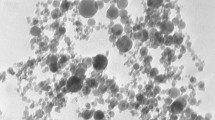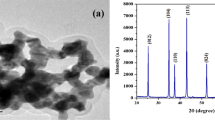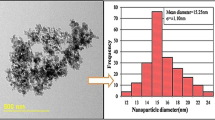Abstract
In this paper, UV–vis spectrum method and dynamic light scattering (DLS) methods were used to evaluate the stability of γ-Al2O3 nanofluid. The results of DLS method indicate that zeta potential increases by increasing ultrasonic mixing time. After 150 min, zeta potential was 50 mV, which under these conditions the nanofluid was stable. The results also show that the size of the nanoclusters decreases with ultrasonic mixing time. The results obtained by UV–vis spectrum indicate that by increasing the ultrasonic mixing time, the value of maximum absorbency increases and after 30 min, it decreases gradually. After 150 min of ultrasonic mixing time, the maximum absorbency becomes constant. This mixing time can be considered as optimum mixing ultrasonic time.











Similar content being viewed by others
References
Alan R (2007) Basic principles of particles size analysis. Malvern Instruments Limited
Azizian R, Doroodchi E et al (2012) Effect of nanoconvection caused by Brownian motion on the enhancement of thermal conductivity in nanofluids. Ind Eng Chem Res 51:1782–1789
Babaei H, Keblinski P et al (2013) A proof for insignificant effect of Brownian motion-induced micro-convection on thermal conductivity by utilizing molecular dynamics simulation. J Appl Phys 113:084302
Chon CH, Kihma KD (2005) Thermal conductivity enhancement of nanofluids by Brownian motion. J Heat Transf 127:810
Chon CH, Kihma KD et al (2005) Empirical correlation finding the role of temperature and particle size for nanofluid (Al2O3) thermal conductivity enhancement. Appl Phys Lett 87(7):153107
Das SK, Putra N et al (2003) Temperature dependence of thermal conductivity enhancement for nanofluids. J Heat Transf 125:567–574
Eastman J, Choi U et al. (1997) Enhanced thermal conductivity through the development of nanofluids. Materials research society symposium proceedings, Cambridge University Press, Cambridge
Evans W, Fish J et al (2006) Role of Brownian motion hydrodynamics on nanofluid thermal conductivity. Appl Phys Lett 88:093116
Farahmandjou M, Sebt S et al (2009) Stability investigation of colloidal FePt nanoparticle systems by spectrophotometer analysis. Chin Phys Lett 26(2):027501
Ghadimi A, Saidur R et al (2011) A review of nanofluid stability properties and characterization in stationary conditions. Int J Heat Mass Transf 54(17):4051–4068
Habibzadeha S, Kazemi-Beydokhti A et al (2010) Stability and thermal conductivity of nanofluids of tin dioxide synthesized via microwave-induced combustion route. Chem Eng J 156:471–478
Haiss W, Thanh NT et al (2007) Determination of size and concentration of gold nanoparticles from UV–vis spectra. Anal Chem 79(11):4215–4221
Hong J, Kim D (2012) Effects of aggregation on the thermal conductivity of alumina/water nanofluids. Thermochim Acta 542:28–32
Hong KS, Hong T et al (2006) Thermal conductivity of Fe nanofluids depending on the cluster size of nanoparticles. Appl Phys Lett 88:031901
Huang J, Wang X et al (2009) Influence of pH on the stability characteristics of nanofluids. In: Photonics and optoelectronics, 2009. SOPO 2009. IEEE, Wuhan
Hwang Y, Lee J et al (2007) Stability and thermal conductivity characteristics of nanofluids. Thermochim Acta 455(1):70–74
Jang SP, Choi SUS (2004) Role of Brownian motion in the enhanced thermal conductivity of nanofluids. Appl Phys Lett 84:4316
Jiang L, Gao L et al (2003) Production of aqueous colloidal dispersions of carbon nanotubes. J Colloid Interface Sci 260(1):89–94
Kreibig U, Genzel L (1985) Optical absorption of small metallic particles. Surf Sci 156:678–700
Lee S, Choi SU et al (1999) Measuring thermal conductivity of fluids containing oxide nanoparticles. J Heat Transf 121(2):280–289
Lee D, Kim JW et al (2006) A new parameter to control heat transport in nanofluids: surface charge state of the particle in suspension. J Phys Chem B 110(9):4323–4328
Leron V (2009) Synthesis and covalent surface modification of carbon nanotubes for preparation of stabilized nanofluid suspensions. Dissertation, McGill University
Li CH, Peterson G (2006) Experimental investigation of temperature and volume fraction variations on the effective thermal conductivity of nanoparticle suspensions (nanofluids). J Appl Phys 99(8):084314–084318
Li X, Zhu D et al (2007) Evaluation on dispersion behavior of the aqueous copper nano-suspensions. J Colloid Interface Sci 310(2):456–463
Mahbubul IM, Chong TH et al (2007) Effect of ultrasonication duration on colloidal structure and viscosity of alumina–water nanofluid. Ind Eng Chem Res 53:6677–6684
Masuda H, Ebata A et al (1993) Alteration of thermal conductivity and viscosity of liquid by dispersing ultra-fine particles. Dispersion of Al2O3, SiO2 and TiO2 ultra-fine particles. Netsu Bussei 7:227–233
Pak BC, Cho YI (1998) Hydrodynamic and heat transfer study of dispersed fluids with submicron metallic oxide particles. Exp Heat Transf Int J 11(2):151–170
Prasher R (2005) Thermal conductivity of nanoscale colloidal solutions (nanofluids). Phys Rev Lett 94(2):025901
Prasher R, Phelan PE et al (2006) Effect of aggregation kinetics on the thermal conductivity of nanoscale colloidal solutions (nanofluid). Nano Lett 6(7):1529–1534
Putra N, Thiesen P et al (2003) Temperature dependence of thermal conductivity enhancement for nanofluids. J Heat Transf 125:567–574
Rao Y (2010) Nanofluids: stability, phase diagram, rheology and applications. Particuology 8(6):549–555
Shalkevich N, Shalkevich A et al (2010) Thermal conductivity of concentrated colloids in different states. J Phys Chem 114(21):9568–9572
Tsai C, Chien H et al (2004) Effect of structural character of gold nanoparticles in nanofluid on heat pipe thermal performance. Mater Lett 58(9):1461–1465
Wang Xj, Li X et al (2009) Influence of pH and SDBS on the stability and thermal conductivity of nanofluids. Energy Fuels 23(5):2684–2689
Wang JJ, Zheng RT et al (2012) Heat conduction mechanisms in nanofluids and suspensions. Nano Today 7:124–136
Wei X, Wang L (2010) Synthesis and thermal conductivity of microfluidic copper nanofluids. Particuology 8(3):262–271
Wu C, Cho TJ et al (2010) Effect of nanoparticle clustering on the effective thermal conductivity of concentrated silica colloids. Phys Rev E 81(1):011406
Xian-Ju W, Xin-Fang L (2009) Influence of pH on Nanofluids’ viscosity and thermal conductivity. Chin Phys Lett 26(5):056601
Xian-Ju W, Hai L et al (2011) Stability of TiO2 and Al2O3 nanofluids. Chin Phys Lett 28(8):086601
Xie H, Wang J et al (2002) Thermal conductivity enhancement of suspensions containing nanosized alumina particles. J Appl Phys 91(7):4568–4572
Yu W, Xie H (2012) A review on nanofluids: preparation, stability mechanisms, and applications. J Nanomater 2012:1–17
Zhu H, Zhang C et al (2007) Preparation and thermal conductivity of suspensions of graphite nanoparticles. Carbon 45(1):226–228
Zhu D, Li X et al (2009) Dispersion behavior and thermal conductivity characteristics of Al2O3–H2O nanofluids. Curr Appl Phys 9(1):131–139
Author information
Authors and Affiliations
Corresponding author
Rights and permissions
About this article
Cite this article
Sadeghi, R., Etemad, S.G., Keshavarzi, E. et al. Investigation of alumina nanofluid stability by UV–vis spectrum. Microfluid Nanofluid 18, 1023–1030 (2015). https://doi.org/10.1007/s10404-014-1491-y
Received:
Accepted:
Published:
Issue Date:
DOI: https://doi.org/10.1007/s10404-014-1491-y




